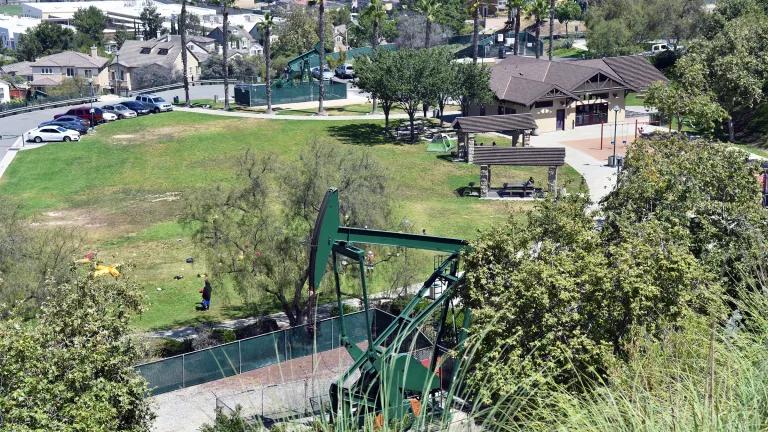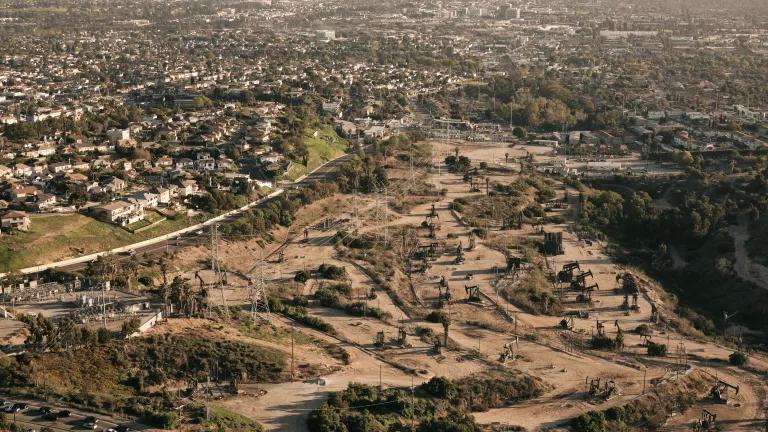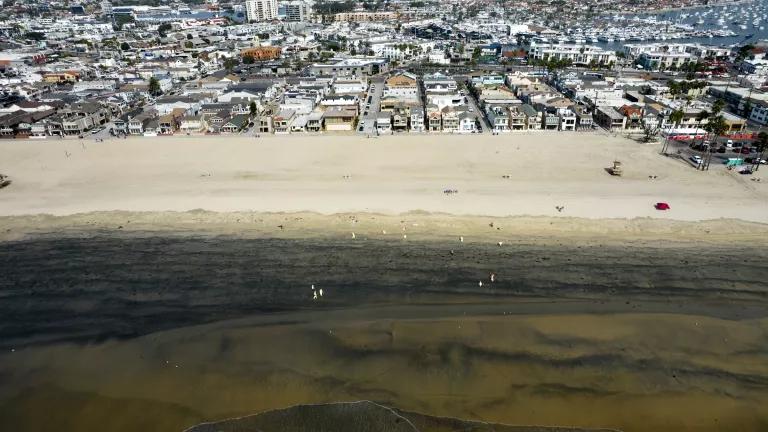No Longer a Laggard: California's Bold Setback Proposal
Californians have the opportunity now to make their views known about the proposed regulation—what’s excellent, and what needs improvement.

An oil pump jack in a park in a residential neighborhood of Los Angeles
Californians have the opportunity now to make their views known about the proposed regulation—what’s excellent, and what needs improvement.
Last week, responding to years of advocacy and protest by communities suffering the health impacts of oil drilling, California’s Governor Gavin Newsom announced a proposed rule requiring a 3,200-foot setback buffer between new oil wells and places where people live and congregate.
To understand just how big a deal this is, you have to put it in context. California has the ignominious distinction of being the only oil- and gas-producing state without any statewide setback buffer on the books. As far as current state law is concerned, you can pretty much drill your oil well in a preschool play yard. Some California municipalities and counties have setback requirements in their zoning codes, but they are for the most part laughably inadequate—distances of a few hundred feet, which don’t come close to protecting people from the toxic fumes spewed out by oil drilling operations.
Most other oil- and gas-producing states aren’t doing much better—except for Colorado, the target of concerted citizen advocacy to reform drilling regulations, which recently got the memo that things needed to change in the setback department. The state’s Oil & Gas Conservation Commission last year announced the largest statewide setback in the nation at that time for new wells: 2,000 feet.
After Governor Newsom ordered his oil and gas regulator two years ago to develop regulations to better protect public health from oil drilling, community advocates hit the streets with a campaign to get the government to establish a statewide setback of at least 2,500 feet. That number became a rallying cry several years ago because an ever-growing body of scientific studies were indicating severe health risk inside of that distance.
To be honest, most of us—used to fighting and negotiating for what we want—were steeled for what we thought was the likelihood the state would come in with a much lower number, and we’d be off to the races. Our pessimism was deepened last year when some in the legislature blocked two attempts to require the state’s regulators to establish a setback and merely consider making it 2,500 feet, after the oil industry funneled millions of lobbying dollars into Sacramento and astroturf opposition.
And therein lies the happy surprise we received last week. The 3,200-foot number was not expected, but neither was it pulled out of a hat. The regulators had assembled a team of public health scientists who examined the relevant science and determined that a kilometer—which is roughly 3,200 feet—was the minimum required to protect people. The scientists’ report, building on years of research and some very recent California-based studies, put together a damning picture of the dangers of living in proximity to drilling—including, among other things, study after study linking such proximity to death and severe health problems in newborns. The scientists systematically dismantled the arguments that industry had been lobbing at the studies, and concluded with “a high level of certainty” that epidemiologic science links drilling to risk of respiratory harm and poor birth outcomes.
In a sane world, it should not actually make headlines when government regulators listen to scientists and regulate based on their findings, but here we are.
It’s also worth noting that the proposed California setback provision, unlike Colorado’s, is remarkably devoid of loopholes. Essentially, the only time an exception will be made to the 3,200-foot setback requirement is when it’s necessary to drill a well to actively alleviate a threat to public safety (for instance, to relieve underground pressure).
In addition to the setback provisions, the draft regulation issued last week establishes engineering controls to limit the impact of existing drilling—still allowed to continue in the setback zone under the proposed rule—on surrounding communities. Operators will be required, among other things, to implement an air pollution leak detection and response plan; end venting of polluting vapors to the atmosphere; provide baseline water sampling before they drill; and put noise controls in place.
To be clear, the proposed regulation isn’t perfect. As noted, it applies only to new wells. It not only allows existing wells to keep operating, but also allows reworking (essentially, more drilling) at the site of existing wells. California may be following other states’ lead in that—setback rules elsewhere generally only apply to new wells—and is presumably trying to limit its vulnerability to legal attacks by industry. Additionally, while the scientists essentially recommended that engineering controls be established for all oil wells in the state, the proposed regulation requires them only within the 3,200-foot setback.
But Californians have the opportunity now to make their views known about the proposed regulation—what’s excellent, and what needs improvement. The proposal is not a formal rulemaking yet; it is a pre-rulemaking draft that regulators are floating to get feedback on, in a comment period that closes December 21. There will be a public workshop on the proposal to solicit public comment on December 1 (details to be announced). NRDC is also encouraging anyone interested in this issue to submit a comment via our action page:
Regulators clearly took comments from NRDC and our partners seriously during the extensive public sessions they held in the process of crafting the rule. The governor’s action has transformed us into cautious optimists for now, so we are hopeful regulators will continue to listen to impacted communities when putting together the formal rulemaking draft sometime next year.
Get more news and information related to a healthy California at Building a Healthy & Equitable California.




